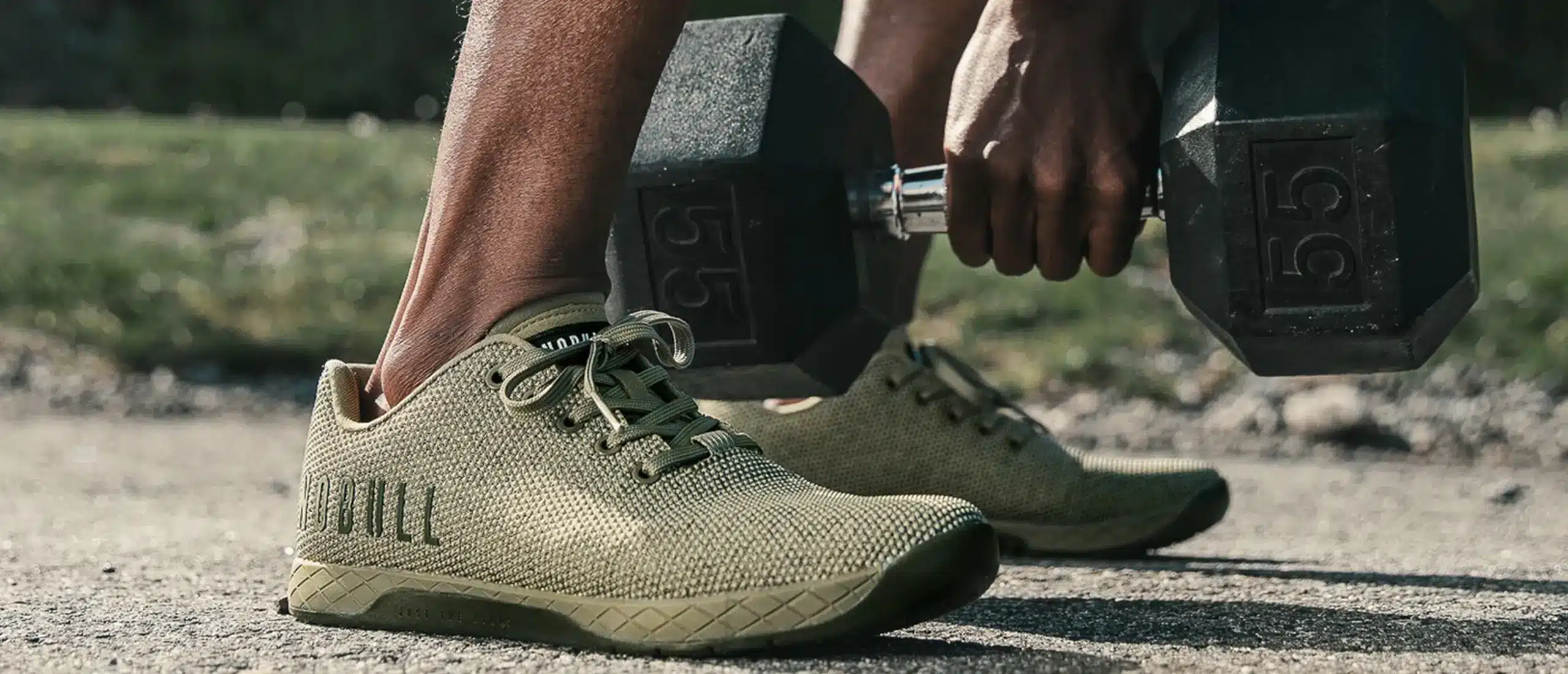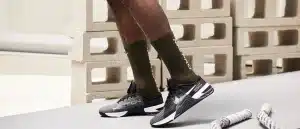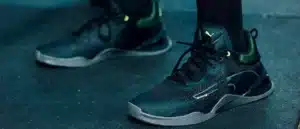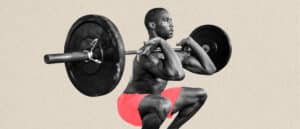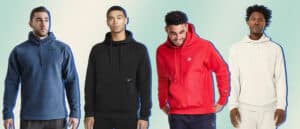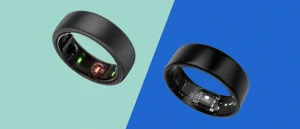NoBull Shoes Review (2024): Are These CrossFit-Famous Trainers Worth the Money?
When it comes to minimalist weightlifting shoes, there might be none more famous than the Converse Chuck Taylor All-Star. What makes them so great? The flat sole allows a lifter to feel more connected to the floor, improving stability and force transfer.
But when it comes to more rigorous WODs involving rope climbs, box jumps, or quick sprints between reps, Converse lack the durability to power through. Enter: NoBull’s training sneakers.
NoBull trainers are beloved for their flat feel, durability, and minimalist design, all of which have made them a match for weight lifting and CrossFit alike. But how do they stack up? I wore a pair through squats, deadlifts, lunges, agility work, and running for over a year to find out.
Want more gym shoe recommendations? Check out our guide to the best gym shoes you can buy. Every product we recommend is tested, reviewed, and compared against the competition.
Why You Should Trust Me
I’m a qualified fitness instructor with a degree in Kinesiology, NASM CPT, CES, FNS, and GPTS, and a professional-personal passion for human performance and corrective exercise. After over a decade in the fitness industry, I’ve shifted my focus to covering fitness, nutrition, and product reviews.
I never review a product without an extensive testing period. For this review, I’ve trained in the NoBull shoes—sometimes called NoBull CrossFit shoes—for a year and several months. These are my honest takes.
What Are NoBull Men’s Trainer Shoes?
Since NoBull shoes hit the market in 2015, they’ve caused quite a stir in the CrossFit community. They uprooted Reebok to steal the sponsor title for the CrossFit games in 2021. And they have an impressive roster of sponsored athletes including CrossFit superstars Tia-Claire Toomey and Justin Medieros.
NoBull also might just be the most heavily debated shoe amongst CrossFitters. You either love NoBulls or you don’t want anything to do with them. Few fall in between.
However you feel, your opinion likely hasn’t wavered, since the NoBull trainers specifically haven’t changed design since the original dropped in 2015. Which could be a good or bad thing depending on who you ask.
The NoBull Trainer reigns supreme when it comes to cross-training shoes that lean towards lifting; its flat and rigid sole is ideal for heavy lifts like squats and deadlifts, while the durable upper provides the support needed for more dynamic CrossFit workouts.
“They’re a bit like Converse All-Stars, but way more durable. The biggest knock against them as a weight lifting shoe is their looks, which, if we’re being honest, isn’t really a knock,” Will Price, Hone Health’s senior reviews editor, said.
We also named them our best gym shoe for people with flat feet in our guide to gym shoes.
NoBull Training Shoes Construction And Materials
The majority of the shoe is made of an abrasion resistant upper the brand calls SuperFabric. It’s rough to the touch, it doesn’t have much give, but it absolutely keeps the shoe looking and feeling new for years after the initial wear (an attribute very few gym shoes possess, including the ever-popular Nike Metcon shoe).
The base is a simple, tacky gum sole with plenty of grip to keep you stable through static or dynamic lifts. On that note, the most boring but maybe most important feature of the shoe’s construction is the very firm sole; or, how the very firm sole works with the extra-wide toe box and minimal heel to toe drop.
The firm sole means your foot is not going to rock slightly in any direction under load, combined with the wide toe box that allows your feet to spread out, thus securing more stability. This, combined with a very flat profile, makes the shoe very, very stable.
What’s Good About the NoBull Men’s Trainer Shoes?
Perfect for weightlifting
As a former Track and Field athlete, I’ve experienced the natural give of more cushioned shoes (i.e. running shoes) while weightlifting. Cushion isn’t the end-all-be-all of weightlifting shoes for me. But, if a shoe offers too much shock absorption during a movement, it can take away from force production—which is why many weightlifters turn to shoes with low cushion during their strength training sessions.
The super-flat midsole and minimal heel drop means NoBull trainers go light on the cushioning. The rock-hard sole is ideal for pushing off during heavy lifts like squats, deadlifts, and lunges, while the rigid upper keeps your foot rooted into place from the side and back.
Great for CrossFit and agility workouts
When I first slipped into my Nobull shoes, I had my doubts about how they would perform during higher-intensity workouts. The upper is rigid. So rigid that I worried I wouldn’t be able to move how I wanted to, let alone quickly.
Burpees and box jumps set me straight. The lack of cushioning decreases response time. I felt quick, springy. The rigid upper helps to keep your foot nestled into place during lateral movements like speed skaters or cuts, so you feel constantly supported.
Minimal design
The design is a plus or minus depending on who you talk to. As a minimalist myself, I prefer the simple design, color range, and patterns Nobull offers. The prints and colors aren’t the most creative, but they pair nicely with the majority of outfits in my closet which is something I always look for when investing in a fresh pair of shoes.
The Nobull trainers aren’t my first choice for casual wear (that would be the Reebok Nano X2), but the shoes are comfortable enough to kick around in if you’re stuck wearing them after the gym.

What’s Not Good About the NoBull Men’s Trainer Shoes?
No arch support
If you do prefer a shoe with some arch support, the NoBull trainers aren’t it. Arch support takes the pressure and work off your foot, which is a good or bad thing depending on what you’re looking for. By taking arch support away it forces your foot to do the work.
On the other hand, arch support can reduce foot pain, and help correct some movement deficiencies for those who deal with foot pronation (or the foot arch collapsing inward). Pronation can take a hit to squat form, for example, causing your knees to cave inward.
Do you want arch support or lack thereof? It comes down to feel, need, and preference.
Not good for running
Hard pass. I tried to run a 5K in my NoBull trainers and didn’t make it more than 800 meters away from my house. I ended up walking home from there.
The lack of arch support makes these shoes terrible for running even short distances. The forefoot isn’t flexible enough to roll with your natural running stride, resulting in a clunky cadence. The rigid heel tab is a blister waiting to happen. You can get away with wearing them during a WOD that has short bursts of running like 100-meter sprints, but even that might be something to endure.
If you are interested in running but love the look and feel of NoBull shoes, the NoBull Runners are designed with more cushion.
Need breaking in
The rigid upper and sole are the main features that make the NoBull trainers so durable, but it means they need breaking in. The upper takes a sharp cut above the toes when you push into the arch of the shoe like during burpees or your back foot during a reverse lunge. I’m a month in, and while I’m enjoying these kicks more and more, I can only guess they’ll relax and get even better with age.
The Experience
Let me preface by saying that prior to this test, I found myself gearing up to dislike the NoBull trainers. I’m not against weight lifting shoes, but I’ve always leaned towards more neutral cross trainers like the On Cloud X Trainers in the gym.
There’s nothing wrong with lifting in everyday cross-training shoes, they’re just very different from the NoBull trainers. Typical cross trainers have a higher heel drop, pushing you onto your toes. They have more shock absorption giving you a little more support during running or high-intensity activities. Plus, they have a little more cushion, which isn’t ideal for weight lifting, but if it’s what you know, you don’t know the difference.
All of these reasons are why I thought I’d hate the Nobull trainers, but turned out to be why I loved them. Especially for weightlifting.
For weight lifting
The flat and rigid arch and upper of the Nobull trainers provide stability and support during my lifts. When I wear them, I feel strong and grounded, which allows me to focus on my lifts rather than teetering around to find my balance between reps. After months of wear, I still reach for these often.
For running
After first slipping my foot into the Nobull trainers, I knew I couldn’t run in them. They’re just too flat. I really gave it my best shot, and left my house with the intention of running a 5K. The arches were barking no more than 400 meters in, and I was forced to turn around. Never again.
For speed and agility
I nearly wrote them off for anything dynamic after that. But to get them a fair shot, I threw in some squat jumps, box jumps, burpees, and speed skaters at the end of my strength workout. Because they’re lightweight, they were surprisingly easy to move around. And where a shoe with more cushion would absorb some of the shock, this slows you down, too. The rigidity of the Nobull trainers helped me feel explosive and springy.
Overall, these shoes are a great match for weight lifting, CrossFit, and HIIT. I’m happy to wear them for a gym session, but when I do I sub my typical warmup jog on the treadmill for an incline walk and mobility work instead.
The Competition
Reebok Nano X2
The Reebok Nano X2 ($140) is the king of all-around training shoes. If you’re after a shoe that can handle running, the high heel drop and wide stability of this shoe help it perform better for running than NoBull trainers. I personally preferred running, and everyday wear in the Reebok Nano X2. I could take either or for agility work. But NoBull is the clear winner for weight lifting.
Nike Metcon
The Nike Metcon ($130) is another worthy adversary. Its blend of stability and versatility make it a good fit for weightlifting and CrossFit. The responsiveness of this shoe is beloved for HIIT and agility workouts. Plus, the classic swoosh always scores a few extra points in my book.
Puma Fuse
All of these shoes come in at the same general price range, but you might want one or the other based on your preferences. If price is the holdup, consider the Puma Fuse is another great gym shoe that racks up a few less bills ($90). They give and flex a bit more throughout the shoe, and also support weightlifting very well, but don’t make for serviceable runners.
NoBull Shoes FAQs
Does NoBull make wide shoes?
The brand does not make shoes specifically for wider feet, no. If you have wider feet, consider looking into other brands. NoBull shoes are typically quite narrow through the midfoot and open up in the toe box, so if your foot is naturally wide, it may be an uncomfortable fit.
Why are NoBull shoes so expensive?
Many shoppers ask why NoBull shoes are pricier than some of the big brands they may be more familiar with. Based on testing and direct comparison, we think NoBull shoes are marginally more expensive because they’re often designed with more specific use cases in mind than the big brands, and with materials that feel a bit more premium.
Are NoBull Shoes good for walking?
The gum trainers are not great walking shoes, but the brand’s other options are. If you want a pair of walking shoes we’d look at the ALLDAY or ASPIRE lines.
Should I size up or down when buying NoBull Shoes?
For most people, NoBull shoes fit true to size. That said, if your foot is wider than normal you might consider sizing up for extra breathing room through the midfoot, or consider another brand that better accommodates your feet.
The Bottom Line
The NoBull trainers are at the intersection of stability and dynamic. This shoe provides superior stability in the weight room—particularly heavy lower body lifts like squats and deadlifts. They’re also surprisingly light and dynamic during agility workouts. If you’re looking for a shoe to level up your gym workouts (and love a flat lifting shoe) this is the perfect pair.


